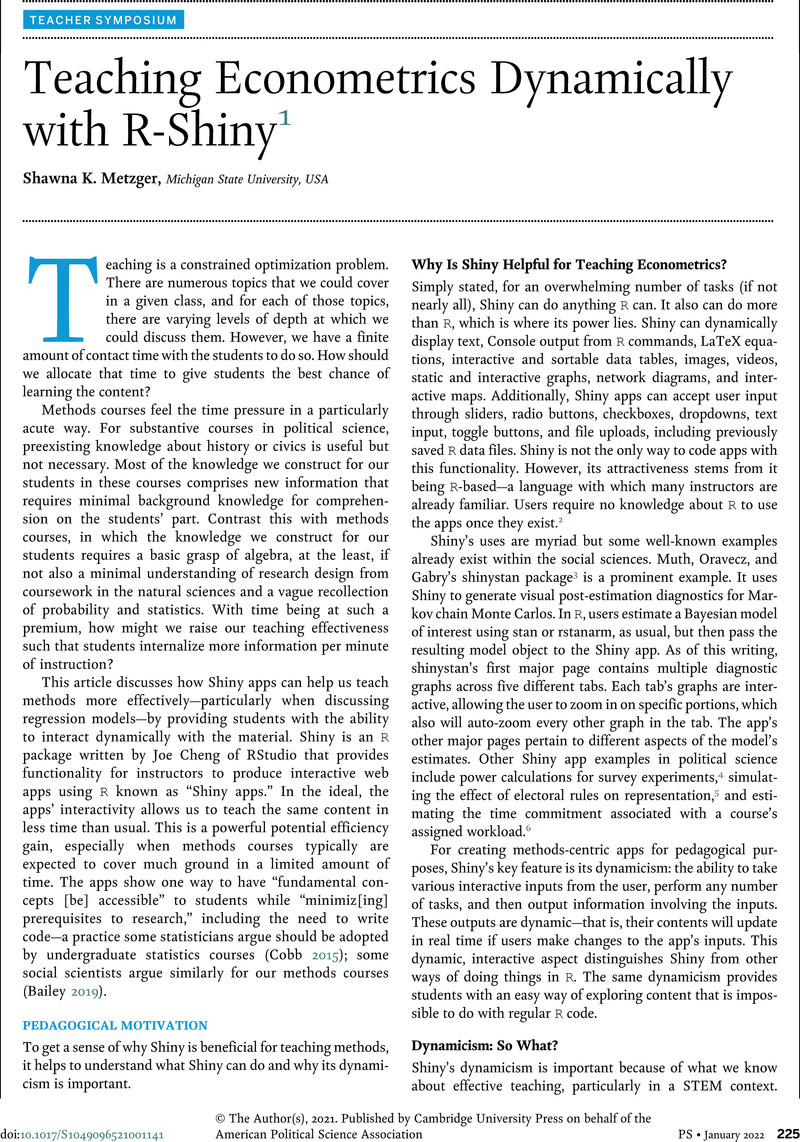No CrossRef data available.
Article contents
Teaching Econometrics Dynamically with R-Shiny
Published online by Cambridge University Press: 21 December 2021
Abstract
An abstract is not available for this content so a preview has been provided. Please use the Get access link above for information on how to access this content.

- Type
- Teaching Political Methodology
- Information
- Copyright
- © The Author(s), 2021. Published by Cambridge University Press on behalf of the American Political Science Association
Footnotes
Portions of this article draw on Metzger’s (2021) Using Shiny to Teach Econometric Methods and are reprinted with permission. All of the apps mentioned in the article are available on GitHub (www.github.com/MetzgerSK) in either the shinyElement or shinyAdvReg repository.
References
REFERENCES
Bacon, Donald R., and Stewart, Kim A.. 2006. “How Fast Do Students Forget What They Learn in Consumer Behavior? A Longitudinal Study.” Journal of Marketing Education 28 (3): 181–92.10.1177/0273475306291463CrossRefGoogle Scholar
Bahls, Patrick. 2012. Student Writing in the Quantitative Disciplines: A Guide for College Faculty. San Francisco: Jossey-Bass Publishers.Google Scholar
Bailey, Michael A. 2019. “Teaching Statistics: Going from Scary, Boring, and Useless to, Well, Something Better.” PS: Political Science & Politics 52 (2): 367–70.Google Scholar
Bean, John C. 2011. Engaging Ideas: The Professor’s Guide to Integrating Writing, Critical Thinking, and Active Learning in the Classroom. 2nd ed. San Francisco: Jossey-Bass Publishers.Google Scholar
Bekkerman, Anton. 2015. “The Role of Simulations in Econometrics Pedagogy.” Wiley Interdisciplinary Reviews: Computational Statistics 7 (2): 160–65.10.1002/wics.1342CrossRefGoogle Scholar
Biggs, John, and Tang, Catherine. 2011. Teaching for Quality Learning at University. 4th ed. Maidenhead, UK: Open University Press.Google Scholar
Carsey, Thomas M., and Harden, Jeffrey J.. 2013. Monte Carlo Simulation and Resampling Methods for Social Science. Los Angeles: SAGE Publications.Google Scholar
Cobb, George. 2015. “Mere Renovation Is Too Little Too Late: We Need to Rethink Our Undergraduate Curriculum from the Ground Up.” The American Statistician 69 (4): 266–82.10.1080/00031305.2015.1093029CrossRefGoogle Scholar
Deslauriers, Louis, McCarty, Logan S., Miller, Kelly, Callaghan, Kristina, and Kestin, Greg. 2019. “Measuring Actual Learning Versus Feeling of Learning in Response to Being Actively Engaged in the Classroom.” Proceedings of the National Academy of Sciences 116 (39): 19251–57.10.1073/pnas.1821936116CrossRefGoogle ScholarPubMed
Doi, Jimmy, Potter, Gail, Wong, Jimmy, Alcaraz, Irvin, and Chi, Peter. 2016. “Web Application Teaching Tools for Statistics Using R and Shiny.” Technology Innovations in Statistics Education 9 (1). https://escholarship.org/uc/item/00d4q8cp.10.5070/T591027492CrossRefGoogle Scholar
Fawcett, Lee. 2018. “Using Interactive Shiny Applications to Facilitate Research-Informed Learning and Teaching.” Journal of Statistics Education 26 (1): 2–16.10.1080/10691898.2018.1436999CrossRefGoogle Scholar
Freeman, Scott, Eddy, Sarah L., McDonough, Miles, Smith, Michelle K., Okoroafor, Nnadozie, Jordt, Hannah, and Wenderoth, Mary Pat. 2014. “Active Learning Increases Student Performance in Science, Engineering, and Mathematics.” Proceedings of the National Academy of Sciences 111 (23): 8410–15.10.1073/pnas.1319030111CrossRefGoogle ScholarPubMed
Groth, Randall E. 2013. Teaching Mathematics in Grades 6–12: Developing Research-Based Instructional Practices. Los Angeles: SAGE Publications.10.4135/9781452244105CrossRefGoogle Scholar
Hancock, Stacey A., and Rummerfield, Wendy. 2020. “Simulation Methods for Teaching Sampling Distributions: Should Hands-On Activities Precede the Computer?” Journal of Statistics Education 28 (1): 9–17.10.1080/10691898.2020.1720551CrossRefGoogle Scholar
Huber, Mary Taylor, Hutchings, Pat, and Gale, Richard. 2005. “Integrative Learning for Liberal Education.” Peer Review 7 (3/4). www.aacu.org/publications-research/periodicals/integrative-learning-liberal-education.Google Scholar
King, Gary, and Sen, Maya. 2013. “How Social Science Research Can Improve Teaching.” PS: Political Science & Politics 46 (3): 621–29.Google Scholar
Kirschner, Paul A., Sweller, John, and Clark, Richard E.. 2006. “Why Minimal Guidance During Instruction Does Not Work: An Analysis of the Failure of Constructivist, Discovery, Problem-Based, Experiential, and Inquiry-Based Teaching.” Educational Psychologist 41 (2): 75–86.10.1207/s15326985ep4102_1CrossRefGoogle Scholar
Menary, Richard. 2007. “Writing as Thinking.” Language Sciences 29 (5): 621–32.10.1016/j.langsci.2007.01.005CrossRefGoogle Scholar
Metzger, Shawna K. 2021. Using Shiny to Teach Econometric Models. Cambridge: Cambridge University Press.10.1017/9781108883993CrossRefGoogle Scholar
Prince, Michael. 2004. “Does Active Learning Work? A Review of the Research.” Journal of Engineering Education 93 (3): 223–31.10.1002/j.2168-9830.2004.tb00809.xCrossRefGoogle Scholar
Ruhl, Kathy L., Hughes, Charles A., and Schloss, Patrick J.. 1987. “Using the Pause Procedure to Enhance Lecture Recall.” Teacher Education and Special Education 10 (1): 14–18.10.1177/088840648701000103CrossRefGoogle Scholar
Yancey, Kathleen Blake. 2009. “Reflection and Electronic Portfolios: Inventing the Self and Reinventing the University.” In Electronic Portfolios 2.0: Emergent Research on Implementation and Impact, eds. Cambridge, Darren, Cambridge, Barbara L., and Yancey, Kathleen Blake, 5–16. Sterling, VA: Stylus Publishing.Google Scholar


